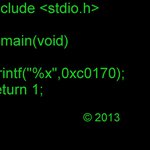The official Mbed 2 C/C++ SDK provides the software platform and libraries to build your applications.
Dependents: hello SerialTestv11 SerialTestv12 Sierpinski ... more
mbed 2
This is the mbed 2 library. If you'd like to learn about Mbed OS please see the mbed-os docs.
TARGET_KL05Z/TOOLCHAIN_GCC_ARM/MKL05Z4.ld
- Committer:
- emilmont
- Date:
- 2014-02-18
- Revision:
- 78:ed8466a608b4
- Child:
- 93:e188a91d3eaa
File content as of revision 78:ed8466a608b4:
/*
* KL05Z ARM GCC linker script file, Martin Kojtal (0xc0170)
*/
MEMORY
{
VECTORS (rx) : ORIGIN = 0x00000000, LENGTH = 0x00000410
FLASH (rx) : ORIGIN = 0x00000410, LENGTH = 32K - 0x00000410
RAM (rwx) : ORIGIN = 0x1FFFFC00, LENGTH = 4K - 0xC0
}
/* Linker script to place sections and symbol values. Should be used together
* with other linker script that defines memory regions FLASH and RAM.
* It references following symbols, which must be defined in code:
* _reset_init : Entry of reset handler
*
* It defines following symbols, which code can use without definition:
* __exidx_start
* __exidx_end
* __etext
* __data_start__
* __preinit_array_start
* __preinit_array_end
* __init_array_start
* __init_array_end
* __fini_array_start
* __fini_array_end
* __data_end__
* __bss_start__
* __bss_end__
* __end__
* end
* __HeapLimit
* __StackLimit
* __StackTop
* __stack
*/
ENTRY(Reset_Handler)
SECTIONS
{
.isr_vector :
{
__vector_table = .;
KEEP(*(.vector_table))
. = ALIGN(4);
} > VECTORS
.text :
{
*(.text*)
KEEP(*(.init))
KEEP(*(.fini))
/* .ctors */
*crtbegin.o(.ctors)
*crtbegin?.o(.ctors)
*(EXCLUDE_FILE(*crtend?.o *crtend.o) .ctors)
*(SORT(.ctors.*))
*(.ctors)
/* .dtors */
*crtbegin.o(.dtors)
*crtbegin?.o(.dtors)
*(EXCLUDE_FILE(*crtend?.o *crtend.o) .dtors)
*(SORT(.dtors.*))
*(.dtors)
*(.rodata*)
KEEP(*(.eh_frame*))
} > FLASH
.ARM.extab :
{
*(.ARM.extab* .gnu.linkonce.armextab.*)
} > FLASH
__exidx_start = .;
.ARM.exidx :
{
*(.ARM.exidx* .gnu.linkonce.armexidx.*)
} > FLASH
__exidx_end = .;
__etext = .;
.data : AT (__etext)
{
__data_start__ = .;
*(vtable)
*(.data*)
. = ALIGN(4);
/* preinit data */
PROVIDE_HIDDEN (__preinit_array_start = .);
KEEP(*(.preinit_array))
PROVIDE_HIDDEN (__preinit_array_end = .);
. = ALIGN(4);
/* init data */
PROVIDE_HIDDEN (__init_array_start = .);
KEEP(*(SORT(.init_array.*)))
KEEP(*(.init_array))
PROVIDE_HIDDEN (__init_array_end = .);
. = ALIGN(4);
/* finit data */
PROVIDE_HIDDEN (__fini_array_start = .);
KEEP(*(SORT(.fini_array.*)))
KEEP(*(.fini_array))
PROVIDE_HIDDEN (__fini_array_end = .);
. = ALIGN(4);
/* All data end */
__data_end__ = .;
} > RAM
.bss :
{
__bss_start__ = .;
*(.bss*)
*(COMMON)
__bss_end__ = .;
} > RAM
.heap :
{
__end__ = .;
end = __end__;
*(.heap*)
__HeapLimit = .;
} > RAM
/* .stack_dummy section doesn't contains any symbols. It is only
* used for linker to calculate size of stack sections, and assign
* values to stack symbols later */
.stack_dummy :
{
*(.stack)
} > RAM
/* Set stack top to end of RAM, and stack limit move down by
* size of stack_dummy section */
__StackTop = ORIGIN(RAM) + LENGTH(RAM);
__StackLimit = __StackTop - SIZEOF(.stack_dummy);
PROVIDE(__stack = __StackTop);
/* Check if data + heap + stack exceeds RAM limit */
ASSERT(__StackLimit >= __HeapLimit, "region RAM overflowed with stack")
}
 mbed official
mbed official




